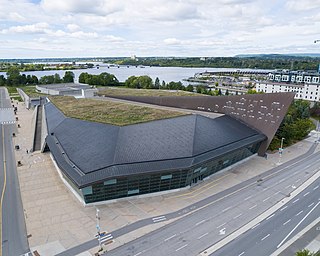
The Canadian War Museum (CWM) is a national museum on the country's military history in Ottawa, Ontario, Canada. The museum serves as both an educational facility on Canadian military history and a place of remembrance. The 40,860 square metres (439,800 sq ft) museum building is situated south of the Ottawa River in LeBreton Flats. The museum houses a number of exhibitions and memorials, in addition to a cafeteria, theatre, curatorial and conservation spaces, as well as storage space. The building also houses the Military History Research Centre, the museum's library and archives.

The Embassy of the United States of America in Ottawa is the diplomatic mission of the United States of America to Canada. Opened in 1999, the embassy complex is located at 490 Sussex Drive in Ottawa, Ontario.

The Bata Shoe Museum (BSM) is a museum of footwear and calceology in Toronto, Ontario, Canada. The museum's building is situated near the northwest of the University of Toronto's St. George campus, in downtown Toronto. The 3,665-square-metre (39,450 sq ft) museum building was designed by Moriyama & Teshima Architects, with Raymond Moriyama as the lead architect.

The Embassy of Canada in Washington, D.C. is Canada's main diplomatic mission to the United States. The embassy building designed by Arthur Erickson and opened in 1989 is located at 501 Pennsylvania Avenue Northwest, Washington, D.C., between the United States Capitol and the White House, just north of the National Gallery of Art. In addition to its diplomatic role, the embassy provides consular services for Delaware, Washington, D.C., Maryland, Virginia, and West Virginia. It also hosts a Trade Commissioner Service office responsible for the states of Maryland, Washington, D.C., Virginia, and West Virginia.

Raymond Junichi Moriyama was a Canadian architect.
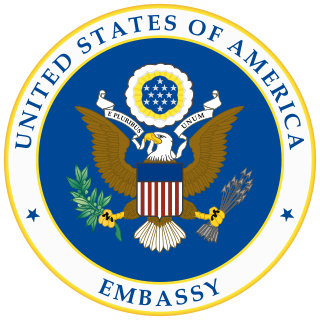
The Embassy of the United States of America in Tokyo represents the United States in Tokyo, Japan. Along with consulates in Osaka, Nagoya, Sapporo, Fukuoka, and Naha, the Embassy provides assistance to American citizens and residents who live in Japan and issues visas to Japanese nationals, and legal residents in Japan who wish to visit or immigrate to the United States.

The Toronto Reference Library is a public reference library in Toronto, Ontario, Canada. It is located on the corner of Yonge Street and Asquith Avenue, within the Yorkville neighbourhood of downtown Toronto and is the largest and most visited branch of Toronto Public Library (TPL).
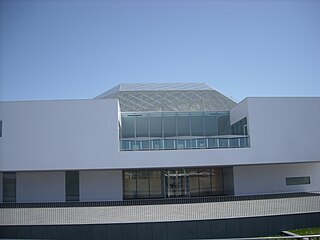
The Delegation of the Ismaili Imamat in Ottawa, Ontario, Canada is representational office of the Ismaili Imamat in Canada and includes the headquarters of the Aga Khan Foundation Canada. It is located between the Embassy of Saudi Arabia and the Lester B. Pearson Building on Sussex Drive. It was opened in 2008.
The Australian Embassy in Paris is located 400 metres southwest of the Eiffel Tower, on Rue Jean Rey in the 15th arrondissement of Paris, near the Bir-Hakeim bridge on the Seine. The embassy is situated on a triangular shaped block, and comprises a pair of nine-storey buildings. The Chancellery Building houses Australia's missions to France, to UNESCO and to the OECD, and the apartment of the ambassador to France; the other building contains 34 staff apartments, all with views of the Seine and the Eiffel Tower.
Ryue Nishizawa is a Japanese architect based in Tokyo. He is a graduate of Yokohama National University, and is director of his own firm, Office of Ryue Nishizawa, established in 1997. In 1995, he co-founded the firm SANAA with the architect Kazuyo Sejima. In 2010, he became the youngest recipient ever of the Pritzker Prize, together with Sejima.
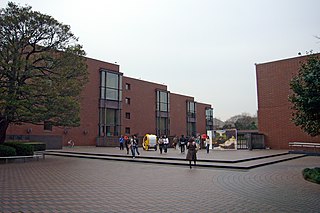
The Tokyo Metropolitan Art Museum is a museum of art located in Ueno Park, Tokyo, Japan. It is one of Japan's many museums which are supported by a prefectural government. The first public art museum in Japan, it opened in 1926 as the Tokyo Prefectural Art Museum and was renamed in 1943 after Tokyo became a metropolitan prefecture. The museum's current building was constructed in 1975 and designed by modernist architect Kunio Maekawa, remaining one his most well-known works today.

The Embassy of Uzbekistan in Washington, D.C.,, is the diplomatic mission of the Republic of Uzbekistan to the United States. The current Ambassador of Uzbekistan to the United States is Furqat Sidikov. The embassy is located at 1746 Massachusetts Avenue NW on Embassy Row in Washington, D.C., between Scott Circle and Dupont Circle. Constructed in 1909, the Clarence Moore House is an example of Beaux Arts architecture in blond Roman brick with limestone dressings; it was used by the Canadian government until the 1980s. The house was listed on the National Register of Historic Places (NRHP) on April 3, 1973. The building is also designated a contributing property to the Massachusetts Avenue Historic District and Dupont Circle Historic District, which are both listed on the NRHP.

The National Museum of Saudi Arabia is a national museum located in the al-Murabba neighborhood of Riyadh, Saudi Arabia. Established in 1999, it is part of the King Abdulaziz Historical Centre and is surrounded by al-Wadi Park to the north and al-Madi Park to the east, who altogether constitute eastern side of the National Museum Park.
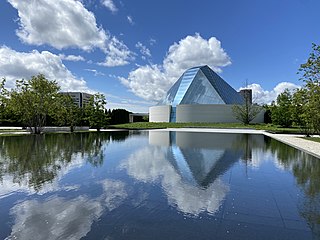
The Ismaili Centre, Toronto is a congregation place and community centre in Toronto, Ontario, Canada, the sixth Ismaili Centre in the world. Situated in a park that it shares with the Aga Khan Museum adjacent to the Don Valley Parkway in North York, Toronto, Ontario, Canada, the Centre represents the permanent presence of the Ismaili Muslim community in Toronto, Ontario and Canada.

The Embassy of Japan in Washington, D.C. is the diplomatic mission of Japan to the United States. It is located at 2520 Massachusetts Avenue NW, Washington, D.C., in the Embassy Row neighborhood. In addition to serving as Japan's diplomatic mission in the United States, the embassy provides Japanese consular services to residents of the District of Columbia, Virginia, and Maryland.

The British Embassy, Tokyo is the chief diplomatic mission of the United Kingdom in Japan, with the Ambassador of the United Kingdom to Japan being the chief of mission. The embassy compound measures about 35,000 m2, located at No 1 Ichibanchō, Chiyoda-ku, Tokyo, to the west of the Imperial Palace, and separated from the latter by a moat.

The Austrian Embassy Tokyo is the main diplomatic mission representing Austria in Japan. It is located in the Minato ward of the Japanese capital Tokyo.

Place des Arts opened its doors as the first multidisciplinary arts centre in Sudbury, Ontario, Canada, in 2022. The architecture firms Moriyama & Teshima and Bélanger Salach were tasked with designing a building to house seven prominent francophone arts and culture organizations united under the Le Regroupement des organismes culturels de Sudbury (ROCS): Carrefour Francophone, La Galerie du Nouvel-Ontario, Centre Franco-Ontarien de Folklore, Concerts La Nuit sur l'étang, Èditions Prise de parole, Théâtre du Nouvel-Ontario (TNO) and the Salon du livre du Grand-Sudbury.
The Embassy of Sweden in Tokyo is Sweden's diplomatic mission in Japan. The mission was opened in 1906. It's located in the Roppongi district in Minato, Tokyo since 1959. The current embassy building was inaugurated in 1991. The ambassador since 2019 is Pereric Högberg. The ambassador has a dual accreditation to Marshall Islands, the Federated States of Micronesia and Palau.
The Embassy of Sweden in Pretoria is Sweden's diplomatic mission in South Africa. The Swedish embassy in South Africa represents the Swedish government in South Africa, Botswana, Namibia and Lesotho. The embassy is located in the suburb of Hatfield in the capital of Pretoria. The ambassador since 2020 is Håkan Juholt.

















